TP-Link C7s User Manual

1910100168 REV1.0.0
Contents
About this guide. . . . . . . . . . . . . . . . . . . . . . . . . . . . . . . . . . . . . . . . . . . . . . . . . . . . . . . i
Chapter 1. Get started . . . . . . . . . . . . . . . . . . . . . . . . . . . . . . . . . . . . . . . . . . . . . . . 1
1. 1 Overview . . . . . . . . . . . . . . . . . . . . . . . . . . . . . . . . . . . . . . . . . . . . . . . . . . . . . . . . . . . . . 1 1. 2 Buttons . . . . . . . . . . . . . . . . . . . . . . . . . . . . . . . . . . . . . . . . . . . . . . . . . . . . . . . . . . . . . . . 1 1. 3 Assemble your device . . . . . . . . . . . . . . . . . . . . . . . . . . . . . . . . . . . . . . . . . . . . . . . . 3 1. 4 Initial setup . . . . . . . . . . . . . . . . . . . . . . . . . . . . . . . . . . . . . . . . . . . . . . . . . . . . . . . . . . . 4 1. 5 Charge your phone . . . . . . . . . . . . . . . . . . . . . . . . . . . . . . . . . . . . . . . . . . . . . . . . . . . 4
Chapter 2. Basics. . . . . . . . . . . . . . . . . . . . . . . . . . . . . . . . . . . . . . . . . . . . . . . . . . . . 6
2. 1 Touchscreen gestures . . . . . . . . . . . . . . . . . . . . . . . . . . . . . . . . . . . . . . . . . . . . . . . . 6 2. 2 Home screen . . . . . . . . . . . . . . . . . . . . . . . . . . . . . . . . . . . . . . . . . . . . . . . . . . . . . . . . . 8 2. 3 Access apps. . . . . . . . . . . . . . . . . . . . . . . . . . . . . . . . . . . . . . . . . . . . . . . . . . . . . . . . . 11 2. 4 Status bar . . . . . . . . . . . . . . . . . . . . . . . . . . . . . . . . . . . . . . . . . . . . . . . . . . . . . . . . . . . 12 2. 5 Notification Panel. . . . . . . . . . . . . . . . . . . . . . . . . . . . . . . . . . . . . . . . . . . . . . . . . . . . 13 2. 6 Quick Settings Panel. . . . . . . . . . . . . . . . . . . . . . . . . . . . . . . . . . . . . . . . . . . . . . . . . 14 2. 7 Type text . . . . . . . . . . . . . . . . . . . . . . . . . . . . . . . . . . . . . . . . . . . . . . . . . . . . . . . . . . . . 15 2. 8 Take a screenshot . . . . . . . . . . . . . . . . . . . . . . . . . . . . . . . . . . . . . . . . . . . . . . . . . . . 16
Chapter 3. Network and Share . . . . . . . . . . . . . . . . . . . . . . . . . . . . . . . . . . . . . . 17
3. 1 WLAN . . . . . . . . . . . . . . . . . . . . . . . . . . . . . . . . . . . . . . . . . . . . . . . . . . . . . . . . . . . . . . . 17 3. 2 Mobile data . . . . . . . . . . . . . . . . . . . . . . . . . . . . . . . . . . . . . . . . . . . . . . . . . . . . . . . . . . 18 3. 3 Connect to computer . . . . . . . . . . . . . . . . . . . . . . . . . . . . . . . . . . . . . . . . . . . . . . . . 19 3. 4 Bluetooth . . . . . . . . . . . . . . . . . . . . . . . . . . . . . . . . . . . . . . . . . . . . . . . . . . . . . . . . . . . . 19 3. 5 Share your mobile data with other devices . . . . . . . . . . . . . . . . . . . . . . . . . . . 20
Chapter 4. Calls and Contacts . . . . . . . . . . . . . . . . . . . . . . . . . . . . . . . . . . . . . . 22
4. 1 Make a call. . . . . . . . . . . . . . . . . . . . . . . . . . . . . . . . . . . . . . . . . . . . . . . . . . . . . . . . . . . 22 4. 2 Answer or reject a call. . . . . . . . . . . . . . . . . . . . . . . . . . . . . . . . . . . . . . . . . . . . . . . . 23 4. 3 Options during a call . . . . . . . . . . . . . . . . . . . . . . . . . . . . . . . . . . . . . . . . . . . . . . . . . 24 4. 4 Call log . . . . . . . . . . . . . . . . . . . . . . . . . . . . . . . . . . . . . . . . . . . . . . . . . . . . . . . . . . . . . . 25 4. 5 Call history . . . . . . . . . . . . . . . . . . . . . . . . . . . . . . . . . . . . . . . . . . . . . . . . . . . . . . . . . . 26 4. 6 Call settings . . . . . . . . . . . . . . . . . . . . . . . . . . . . . . . . . . . . . . . . . . . . . . . . . . . . . . . . . 27 4. 7 Contacts . . . . . . . . . . . . . . . . . . . . . . . . . . . . . . . . . . . . . . . . . . . . . . . . . . . . . . . . . . . . 28
Chapter 5. Messages . . . . . . . . . . . . . . . . . . . . . . . . . . . . . . . . . . . . . . . . . . . . . . . 32
5. 1 Type of messages . . . . . . . . . . . . . . . . . . . . . . . . . . . . . . . . . . . . . . . . . . . . . . . . . . . 32 5. 2 Send, receive and reply to a message . . . . . . . . . . . . . . . . . . . . . . . . . . . . . . . . 32 5. 3 Manage messages. . . . . . . . . . . . . . . . . . . . . . . . . . . . . . . . . . . . . . . . . . . . . . . . . . . 33
Chapter 6. Camera and Photos . . . . . . . . . . . . . . . . . . . . . . . . . . . . . . . . . . . . . 35
6. 1 Camera at a glance . . . . . . . . . . . . . . . . . . . . . . . . . . . . . . . . . . . . . . . . . . . . . . . . . . 35 6. 2 Take a photo . . . . . . . . . . . . . . . . . . . . . . . . . . . . . . . . . . . . . . . . . . . . . . . . . . . . . . . . . 36 6. 3 Record a video. . . . . . . . . . . . . . . . . . . . . . . . . . . . . . . . . . . . . . . . . . . . . . . . . . . . . . . 36 6. 4 Shooting modes . . . . . . . . . . . . . . . . . . . . . . . . . . . . . . . . . . . . . . . . . . . . . . . . . . . . . 36 6. 5 Camera and video settings. . . . . . . . . . . . . . . . . . . . . . . . . . . . . . . . . . . . . . . . . . . 37 6. 6 Photos. . . . . . . . . . . . . . . . . . . . . . . . . . . . . . . . . . . . . . . . . . . . . . . . . . . . . . . . . . . . . . . 38
Chapter 7. Calendar . . . . . . . . . . . . . . . . . . . . . . . . . . . . . . . . . . . . . . . . . . . . . . . . 40
7. 1 Use the calendar. . . . . . . . . . . . . . . . . . . . . . . . . . . . . . . . . . . . . . . . . . . . . . . . . . . . . 40 7. 2 Calendar settings . . . . . . . . . . . . . . . . . . . . . . . . . . . . . . . . . . . . . . . . . . . . . . . . . . . . 41
Chapter 8. Clock. . . . . . . . . . . . . . . . . . . . . . . . . . . . . . . . . . . . . . . . . . . . . . . . . . . . 42
8. 1 Alarm . . . . . . . . . . . . . . . . . . . . . . . . . . . . . . . . . . . . . . . . . . . . . . . . . . . . . . . . . . . . . . . . 42
8. 2 Worldclock . . . . . . . . . . . . . . . . . . . . . . . . . . . . . . . . . . . . . . . . . . . . . . . . . . . . . . . . . . 42
8. 3 Timer . . . . . . . . . . . . . . . . . . . . . . . . . . . . . . . . . . . . . . . . . . . . . . . . . . . . . . . . . . . . . . . . 43
8. 4 Stopwatch . . . . . . . . . . . . . . . . . . . . . . . . . . . . . . . . . . . . . . . . . . . . . . . . . . . . . . . . . . . 43
8. 5 Settings . . . . . . . . . . . . . . . . . . . . . . . . . . . . . . . . . . . . . . . . . . . . . . . . . . . . . . . . . . . . . 43
Chapter 9. Browser . . . . . . . . . . . . . . . . . . . . . . . . . . . . . . . . . . . . . . . . . . . . . . . . . 45
9. 1 Go to a webpage. . . . . . . . . . . . . . . . . . . . . . . . . . . . . . . . . . . . . . . . . . . . . . . . . . . . . 45 9. 2 Browser tabs . . . . . . . . . . . . . . . . . . . . . . . . . . . . . . . . . . . . . . . . . . . . . . . . . . . . . . . . 46
Chapter 10.Google Play . . . . . . . . . . . . . . . . . . . . . . . . . . . . . . . . . . . . . . . . . . . . . 47
10. 1 Add an account to your Google Play. . . . . . . . . . . . . . . . . . . . . . . . . . . . . . . . . . 47 10. 2 Download and install apps . . . . . . . . . . . . . . . . . . . . . . . . . . . . . . . . . . . . . . . . . . . 47
Chapter 11.Themes . . . . . . . . . . . . . . . . . . . . . . . . . . . . . . . . . . . . . . . . . . . . . . . . . 48
11. 1 Change the theme . . . . . . . . . . . . . . . . . . . . . . . . . . . . . . . . . . . . . . . . . . . . . . . . . . . 48 11. 2 Change the wallpaper. . . . . . . . . . . . . . . . . . . . . . . . . . . . . . . . . . . . . . . . . . . . . . . . 48 11. 3 Change the icon style. . . . . . . . . . . . . . . . . . . . . . . . . . . . . . . . . . . . . . . . . . . . . . . . 49
Chapter 12.Weather . . . . . . . . . . . . . . . . . . . . . . . . . . . . . . . . . . . . . . . . . . . . . . . . . 50
12. 1 Check the weather. . . . . . . . . . . . . . . . . . . . . . . . . . . . . . . . . . . . . . . . . . . . . . . . . . . 50 12. 2 Weather settings . . . . . . . . . . . . . . . . . . . . . . . . . . . . . . . . . . . . . . . . . . . . . . . . . . . . 50
Chapter 13.Files. . . . . . . . . . . . . . . . . . . . . . . . . . . . . . . . . . . . . . . . . . . . . . . . . . . . . 51
13. 1 View folders or files. . . . . . . . . . . . . . . . . . . . . . . . . . . . . . . . . . . . . . . . . . . . . . . . . . 51 13. 2 Manage folders or files. . . . . . . . . . . . . . . . . . . . . . . . . . . . . . . . . . . . . . . . . . . . . . . 52 13. 3 Files settings . . . . . . . . . . . . . . . . . . . . . . . . . . . . . . . . . . . . . . . . . . . . . . . . . . . . . . . . 52
Chapter 14.Tools . . . . . . . . . . . . . . . . . . . . . . . . . . . . . . . . . . . . . . . . . . . . . . . . . . . . 53
14. 1 Notes. . . . . . . . . . . . . . . . . . . . . . . . . . . . . . . . . . . . . . . . . . . . . . . . . . . . . . . . . . . . . . . . 53 14. 2 Downloads . . . . . . . . . . . . . . . . . . . . . . . . . . . . . . . . . . . . . . . . . . . . . . . . . . . . . . . . . . 53 14. 3 SIM Toolkit. . . . . . . . . . . . . . . . . . . . . . . . . . . . . . . . . . . . . . . . . . . . . . . . . . . . . . . . . . . 55 14. 4 Feedback. . . . . . . . . . . . . . . . . . . . . . . . . . . . . . . . . . . . . . . . . . . . . . . . . . . . . . . . . . . . 55 14. 5 Calculator . . . . . . . . . . . . . . . . . . . . . . . . . . . . . . . . . . . . . . . . . . . . . . . . . . . . . . . . . . . 55 14. 6 Sound Recorder . . . . . . . . . . . . . . . . . . . . . . . . . . . . . . . . . . . . . . . . . . . . . . . . . . . . . 57 14. 7 FM Radio . . . . . . . . . . . . . . . . . . . . . . . . . . . . . . . . . . . . . . . . . . . . . . . . . . . . . . . . . . . . 58 14. 8 Screen capture . . . . . . . . . . . . . . . . . . . . . . . . . . . . . . . . . . . . . . . . . . . . . . . . . . . . . . 59
Chapter 15.Settings . . . . . . . . . . . . . . . . . . . . . . . . . . . . . . . . . . . . . . . . . . . . . . . . . 60
15. 1 Dual SIM settings . . . . . . . . . . . . . . . . . . . . . . . . . . . . . . . . . . . . . . . . . . . . . . . . . . . . 60 15. 2 Data usage . . . . . . . . . . . . . . . . . . . . . . . . . . . . . . . . . . . . . . . . . . . . . . . . . . . . . . . . . . 61 15. 3 VPN . . . . . . . . . . . . . . . . . . . . . . . . . . . . . . . . . . . . . . . . . . . . . . . . . . . . . . . . . . . . . . . . . 61 15. 4 Airplane mode . . . . . . . . . . . . . . . . . . . . . . . . . . . . . . . . . . . . . . . . . . . . . . . . . . . . . . . 62 15. 5 Private DNS. . . . . . . . . . . . . . . . . . . . . . . . . . . . . . . . . . . . . . . . . . . . . . . . . . . . . . . . . . 62 15. 6 Connected devices . . . . . . . . . . . . . . . . . . . . . . . . . . . . . . . . . . . . . . . . . . . . . . . . . . 62 15. 7 Apps and notifications . . . . . . . . . . . . . . . . . . . . . . . . . . . . . . . . . . . . . . . . . . . . . . . 62 15. 8 Battery . . . . . . . . . . . . . . . . . . . . . . . . . . . . . . . . . . . . . . . . . . . . . . . . . . . . . . . . . . . . . . 63 15. 9 Display . . . . . . . . . . . . . . . . . . . . . . . . . . . . . . . . . . . . . . . . . . . . . . . . . . . . . . . . . . . . . . 64 15. 10Scheduled power on/off . . . . . . . . . . . . . . . . . . . . . . . . . . . . . . . . . . . . . . . . . . . . . .65 15. 11 Navigation bar . . . . . . . . . . . . . . . . . . . . . . . . . . . . . . . . . . . . . . . . . . . . . . . . . . . . . . . 65 15. 12 Sound . . . . . . . . . . . . . . . . . . . . . . . . . . . . . . . . . . . . . . . . . . . . . . . . . . . . . . . . . . . . . . . 65 15. 13 Storage. . . . . . . . . . . . . . . . . . . . . . . . . . . . . . . . . . . . . . . . . . . . . . . . . . . . . . . . . . . . . . 66 15. 14 Security . . . . . . . . . . . . . . . . . . . . . . . . . . . . . . . . . . . . . . . . . . . . . . . . . . . . . . . . . . . . . 66 15. 15 Location . . . . . . . . . . . . . . . . . . . . . . . . . . . . . . . . . . . . . . . . . . . . . . . . . . . . . . . . . . . . . 69 15. 16 Accounts . . . . . . . . . . . . . . . . . . . . . . . . . . . . . . . . . . . . . . . . . . . . . . . . . . . . . . . . . . . . 69 15. 17 Accessibility . . . . . . . . . . . . . . . . . . . . . . . . . . . . . . . . . . . . . . . . . . . . . . . . . . . . . . . . . 69
15. 18 Languages and input. . . . . . . . . . . . . . . . . . . . . . . . . . . . . . . . . . . . . . . . . . . . . . . . . 71 15. 19 Gestures. . . . . . . . . . . . . . . . . . . . . . . . . . . . . . . . . . . . . . . . . . . . . . . . . . . . . . . . . . . . . 71 15. 20 Date and time. . . . . . . . . . . . . . . . . . . . . . . . . . . . . . . . . . . . . . . . . . . . . . . . . . . . . . . . 71 15. 21 Backup and reset . . . . . . . . . . . . . . . . . . . . . . . . . . . . . . . . . . . . . . . . . . . . . . . . . . . . 72 15. 22 Multiple users. . . . . . . . . . . . . . . . . . . . . . . . . . . . . . . . . . . . . . . . . . . . . . . . . . . . . . . . 72 15. 23 System update . . . . . . . . . . . . . . . . . . . . . . . . . . . . . . . . . . . . . . . . . . . . . . . . . . . . . . 74 15. 24 About phone. . . . . . . . . . . . . . . . . . . . . . . . . . . . . . . . . . . . . . . . . . . . . . . . . . . . . . . . . 74
Appendix A: Specifications . . . . . . . . . . . . . . . . . . . . . . . . . . . . . . . . . . . . . . . . . . 75 Appendix B: Technical Support . . . . . . . . . . . . . . . . . . . . . . . . . . . . . . . . . . . . . . 77 Appendix C: Explanation of the symbols on the product label . . . . . . . . 83 Appendix D: Authentication . . . . . . . . . . . . . . . . . . . . . . . . . . . . . . . . . . . . . . . . . 84

About this guide
This guide is a complement to Quick Start Guide. The Quick Start Guide provides instructions for quick setup, while this guide provides details of each function and shows how to configure the smart phone appropriate to your needs.
When using this guide, please notice that features of the device may vary slightly depending on the model and software version you have, and on your location, language, and internet service provider. All screenshots, images, parameters and descriptions documented in this guide are used for demonstration only.
Conventions
In this guide, the following conventions are used:
Convention |
Description |
|
Smart phone/phone |
Stands for Neffos C7s without any explanation. |
|
Parameters |
Parameters provided in the screenshots are just references for configuring the smart phone, which |
|
may be different from the actual situation. You can set the parameters according to your demand. |
||
|
||
Underlined |
Underlined words or phrases are hyperlinks. You can click to redirect to a specific section for more |
|
details. |
||
|
||
Screenshots |
The demonstrated screenshots may look a little different from the actual UI of your smart phone |
|
due to the various firmware versions. Please just configure your phone based on the actual UI. |
||
|
||
> |
The menu structure which shows the path to enter the corresponding page. For example, Settings |
|
> WLAN means the WLAN function page is under the Settings menu. |
||
|
||
Note: |
Highlights important information and tips, and provides additional information. |
|
Caution: |
Indicates potential problems that may arise if proper care or attention is not given. |
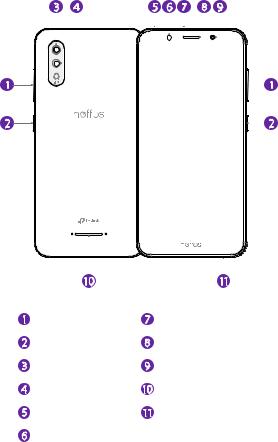
1 |
Get started |
This chapter introduces the smart phone’s hardware information and guides you how to assemble your phone when you get started on using your new phone.
•Overview
•Buttons
•Assemble your device
•Initial setup
•Charge your phone
1. 1 Overview
|
|
|
|
|
|
|
|
|
|
|
|
|
|
|
|
|
|
|
|
|
|
|
|
|
|
|
|
|
|
|
|
|
|
|
|
|
|
|
|
|
|
|
|
|
|
|
|
|
|
|
|
|
|
|
|
|
|
|
|
|
|
|
|
|
|
|
|
|
|
|
|
|
|
|
|
|
|
|
|
|
|
|
|
|
|
|
|
|
|
|
|
|
|
|
|
|
|
|
|
|
|
|
|
|
|
|
|
|
|
|
|
|
|
|
|
|
|
|
|
|
|
|
|
|
|
|
|
|
|
|
|
|
|
|
|
|
|
|
|
|
|
|
|
|
|
|
|
|
|
|
|
|
|
|
|
|
|
|
|
|
|
|
|
|
|
|
|
|
|
|
|
|
|
|
|
Volume buttons |
|
Charging/data port |
|||||||||||||
Power button |
|
Earpiece |
|||||||||||||
Rear camera |
|
Front camera |
|||||||||||||
Flash |
|
Speaker |
|||||||||||||
Headphone jack |
|
Microphone |
|||||||||||||
Flash |
|
|
|
|
|
|
|
|
|
|
|
||||
1. 2 Buttons
The buttons you use with Neffos include virtual ones and physical ones.
Power button
•Lock Neffos: Locking your phone makes the phone sleep, saves the battery and prevents unmeant operations on the screen. You can still receive phone calls, text messages, alarms
Chapter 1 . Get started |
1 |
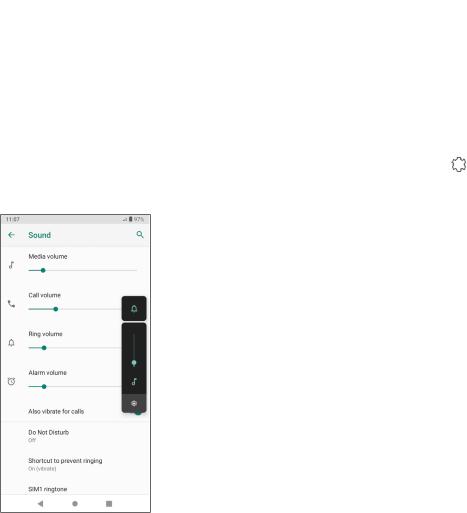
and notifications as well as listen to music and adjust the volume. Press the Power button to manually lock the screen. Neffos locks the screen automatically in a given period of inactivity.
•Unlock Neffos: Press the Power button to wake the screen.
•Turn Neffos on: Press and hold the Power button until your phone vibrates and the screen turns on.
 Note: If your phone does not respond after holding down the Power button for 10 seconds, the battery may be empty. Connect your phone to a charger to charge the battery.
Note: If your phone does not respond after holding down the Power button for 10 seconds, the battery may be empty. Connect your phone to a charger to charge the battery.
•Turn Neffos off: Press and hold the Power button, then tap  Power off.
Power off.
•Reboot Neffos: Press and hold the Power button, then tap  Restart.
Restart.
Volume button
•Adjust volume
Press the Volume-up or Volume-down button to adjust the audio volume when you’re on the phone, listening to songs, watching movies or using other media. You can adjust volume in following two ways:
•Press and hold the Volume-up or Volume-down button until the ring volume meets your needs.
•Press the Volume-up or Volume-down button, and drag the slider for ring volume. Tap  to expand the panel to adjust media and alarm volume.
to expand the panel to adjust media and alarm volume.
 Tap to adjust the volume mode
Tap to adjust the volume mode
 Drag or tap the slider to adjust the volume
Drag or tap the slider to adjust the volume
 Tap to expand the Volume Panel
Tap to expand the Volume Panel
•Take a picture
Press the Volume button to take a picture. Refer to Take a photo to learn more.
•Take a screenshot
Press the Power button and Volume-down button at the same time to take a screenshot.
Chapter 1 . Get started |
2 |
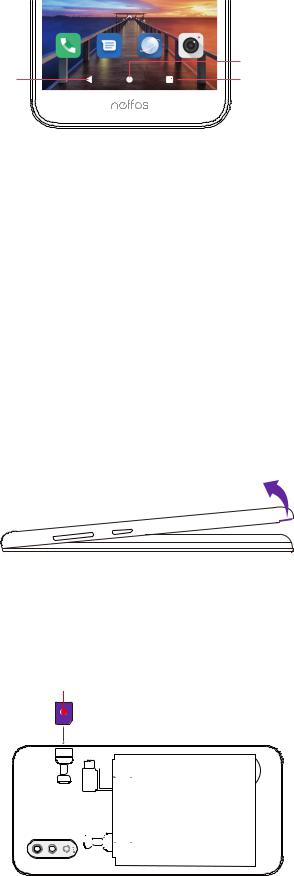
Navigation buttons
Home button
Back button |
Recent apps button |
•Home button
Tap Home button to return to the default Home screen. Tap and hold Home button to open Google Assistant.
•Back button
Tap Back button to return to the previous screen or close an app. When entering text, tap Back button to close the onscreen keyboard.
•Recent apps button
Tap Recent apps button to display recently used apps. Double-tap Recent apps button to switch to the previous app.
1. 3 Assemble your device
Remove the back cover
Switch the device off and disconnect the charger and any other device before removing any covers. Hold your phone face down, put a fingernail in the bottom corner hole in the cover and pry the back cover off.
 Caution: Do not bend or twist the back cover excessively in case you damage the phone.
Caution: Do not bend or twist the back cover excessively in case you damage the phone.
Insert cards
Carefully slide the cards into the card slots with the gold contacts facing down. Your phone supports one Nano SIM card, one Micro SIM card and one MicroSD card. You can use one or two SIM cards by putting them in the corresponding card slots.
Nano SIM card
SIM 1
SD  micro
micro

 Micro SD card
Micro SD card



 SIM 2
SIM 2 



 Nano SIM card
Nano SIM card
Chapter 1 . Get started |
3 |

 Caution:
Caution:
1.If the card is not inserted correctly, the phone will not detect it.
2.Your phone supports only dual card dual standby single pass, which means you cannot use both SIM cards for calls or data services simultaneously.
Insert the battery
Insert the battery into the opening on the back of the phone, aligning the gold contacts on the battery with the gold contacts in your phone. Then gently press down to secure the battery.
Replace the back cover
Align the cover and press all the way around the cover’s edges, making sure it snaps into place.
1. 4 Initial setup
It is recommended to insert your SIM cards before you start the initial setup.
Press and hold the Power button to turn on your phone, and then follow the onscreen instructions to complete the initial setup.
 Note: To avoid low battery power, your phone will shut down automatically if not operated on initial setup screen in 30 minutes.
Note: To avoid low battery power, your phone will shut down automatically if not operated on initial setup screen in 30 minutes.
1.Select your language and tap START.
2.If you insert only one SIM card, your device will skip this step automatically.
If you insert two SIM cards, your device will proceed to dual-SIM settings. Follow the onscreen instructions to finish dual-SIM settings. You can always adjust dual-SIM settings in Settings
> Network & Internet > SIM cards.
If you don’t insert any SIM card, your device will proceed to Connect to mobile network screen. Read the Insert SIM Card tips and tap SKIP.
3.Proceed to Connect to WLAN screen.
Your phone will automatically list available WLAN networks. Select the network you want to connect to (If you want to view more WLAN networks, tap See all WLAN networks), and then enter the password to access the network (This can take up to 2 minutes). If you have activated mobile data services with your carrier, you can tap Use mobile network for setup. Or if you don’t
want to connect to network, just tap SKIP > CONTINUE to skip this step.
 Note: Using cellular network for setup may result in additional fees. Contact your carrier for information about your cellular data plan rates.
Note: Using cellular network for setup may result in additional fees. Contact your carrier for information about your cellular data plan rates.
4.Proceed to GoogleTM Services screen. Read the Google terms and conditions, then tap
ACCEPT.
5.Proceed to TouchPal Privacy Policy screen. Tap Agree to continue.
6.Proceed to Set screen lock screen. Tap Screen lock options to select a device protection feature and then follow the onscreen instructions to complete. If you don’t want to set now, tap
SKIP > SKIP ANYWAY. You can always set your device protection in Settings > Security & location > Screen lock.
7. Setup completed. Your phone is ready for use.
1. 5 Charge your phone
Your device displays a low battery warning when the battery is nearly empty, and your phone will turn off automatically. Charge your device immediately to prevent it from switching off automatically.
 Caution:
Caution:
1.When charging your phone, only use genuine Neffos batteries, chargers, and USB cables. Third-party accessories are a potential safety hazard and may impair your phone’s performance.
Chapter 1 . Get started |
4 |

2.Avoid using your phone when it is charging. Do not cover your phone or the power adapter.
3.It is entirely normal that your phone may become warm after prolonged use or when exposed to high ambient temperatures. If your phone becomes hot to the touch, stop charging it and disable unnecessary features. Place your phone in a cool location and allow it to cool down to room temperature. Avoid prolonged contact with the surface of your phone if it becomes hot.
Use the charger to charge your device
Connect your phone to a mains socket using the charger and USB cable that came with your phone.
Use a USB port to charge your device
Charge your device by connecting it to a computer with a USB cable.
If another USB connection mode has been selected, swipe down from the status bar to open the Notification Panel. Tap the notification of USB connection mode, and then select Charge this device.
View the battery status
The battery status is indicated by the battery icon in the status bar by default. To show remaining battery percentage in the status bar, go to Settings > Battery and switch on Battery percentage. Refer to Battery to learn more about battery.
Chapter 1 . Get started |
5 |

2 Basics
Learn about your smart phone’s basic features.
•Touchscreen gestures
•Home screen
•Access apps
•Status bar
•Notification Panel
•Quick Settings Panel
•Type text
•Take a screenshot
2. 1 Touchscreen gestures
Use simple touchscreen gestures to perform a variety of tasks, such as launching apps, scrolling through lists, and zooming images.
Tap: Simply tap an item once. For example, tap to select an option or open an app.
Double-tap: Tap the target area of the screen twice in quick succession. For example, double-tap an image in full screen mode to zoom in or out.
|
|
|
Chapter 2 . Basics |
6 |
|

Tap and hold: Tap and leave your finger on the screen for 2 seconds or more to activate onscreen items. For example, tap and hold a widget on the Home screen to move it.
Swipe: Place your finger on the screen, and drag your finger to the direction you want. For example, you can swipe to scroll through the Home screen or a list.
Drag: Tap and hold an item and then move it to another position. For example, you can rearrange apps and widgets on the Home screen.
|
|
|
|
|
|
|
|
|
|
|
|
|
|
|
|
|
|
Chapter 2 . Basics |
7 |
||||
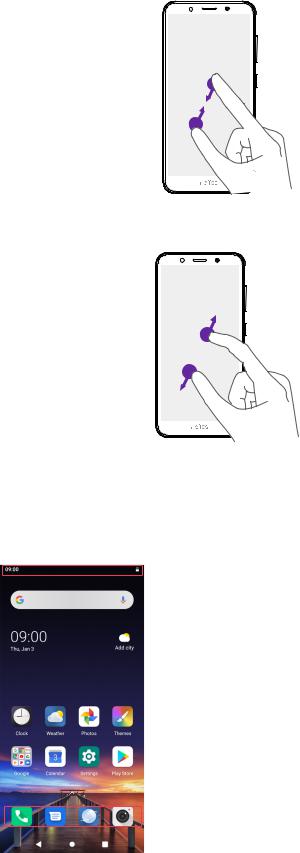
Pinch fingers together: Pinch two fingers together on the screen. For example, pinch two fingers together to zoom out on a picture.
Spread fingers apart: Spread two fingers apart on the screen. For example, pinch two fingers out to zoom in on a picture.
2. 2 Home screen
Use the Home screen to access your apps and widgets.
 Status bar: Displays status and notification icons
Status bar: Displays status and notification icons
 Widget: Self-contained apps that run on the
Widget: Self-contained apps that run on the
Home screen (not shortcuts)
 App drawer: Tap to open app list
App drawer: Tap to open app list
 Dock component bar: Shortcuts to your frequently used apps
Dock component bar: Shortcuts to your frequently used apps
Chapter 2 . Basics |
8 |
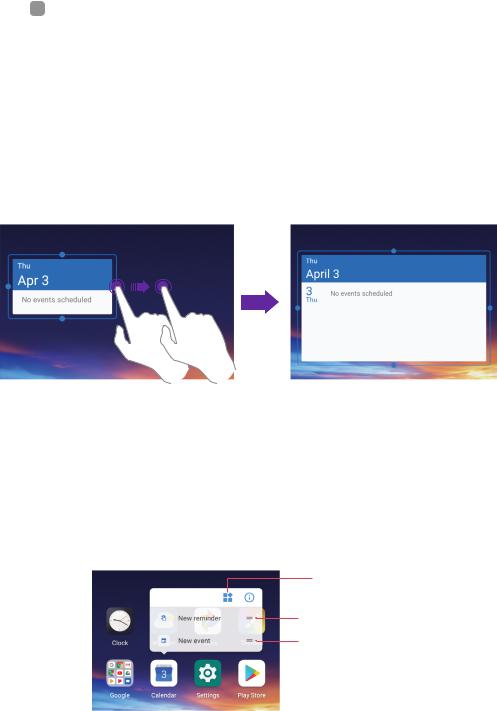
Organize widgets on the Home screen
•Add a widget to the Home screen
Add frequently used widgets to the Home screen for quick access.
1. On the Home screen, tap and hold a blank area (or pinch two fingers together) to access the Home screen editor.
2. Tap  Widgets. Swipe right or left to view and select a widget. Drag the widget to the target area.
Widgets. Swipe right or left to view and select a widget. Drag the widget to the target area.
3. Tap a blank area on the Home screen (or tap Home button or Back button) to quit the Home screen editor.
 Note: You must have enough space on the Home screen to add widgets. If there is not enough space, add another Home screen (see Add a Home screen) or free up some space.
Note: You must have enough space on the Home screen to add widgets. If there is not enough space, add another Home screen (see Add a Home screen) or free up some space.
•Move a widget
On the Home screen, tap and hold a widget and then drag it to the desired location.
•Adjust a widget size
1. Tap and hold the widget, and then drag a dot on the contour line to adjust the size. 2. Tap a blank area (or tap Home button or Back button) to finish.
•Delete a widget
On the Home screen, tap and hold the widget you want to delete and drag it to Remove on the status bar.
Organize apps on the Home screen
•App pop up box
On the Home screen, tap and hold an app to open the pop up box.
Widget
 App information
App information
 Shortcut
Shortcut
•View app info: Tap  .
.
•Shortcut: Tap the shortcut to go to the target interface quickly. Tap and hold the shortcut and drag it to the target area to add it on the Home screen, so that you can find it more easily.
Chapter 2 . Basics |
9 |

• Widget to Home screen: Tap to view the widgets. Tap and hold the widget and drag it to your target area to add it on the Home screen.
 Note: Widget and shortcut only appear when the app includes related content.
Note: Widget and shortcut only appear when the app includes related content.
•App drawer
On the Home screen, tap  or swipe it up on the dock component bar to expand the app drawer. You can enter some key words in search bar to search the app you need.
or swipe it up on the dock component bar to expand the app drawer. You can enter some key words in search bar to search the app you need.
•Add an app icon to the Home screen
1. On the Home screen, tap  or swipe it up on the dock component bar to expand app drawer.
or swipe it up on the dock component bar to expand app drawer.
2. Tap and hold an app and drag it to the target area.
•Move an app
On the Home screen, tap and hold an app and then drag it to the desired location.
•Uninstall an app
On the Home screen, tap and hold the app and then drag it to Uninstall on the status bar.
 Note: Some pre-installed system apps cannot be uninstalled.
Note: Some pre-installed system apps cannot be uninstalled.
•Remove an app icon
On the Home screen, tap and hold the app you want to remove, then drag it to Remove on the status bar.
•Align all the icons quickly
1. On the Home screen, tap and hold a blank area on the screen (or pinch two fingers together) to access the Home screen editor.
2. Tap 
 Adjustment and slide upward or downward with two fingers within icon display area to automatically arrange the Home screen icons.
Adjustment and slide upward or downward with two fingers within icon display area to automatically arrange the Home screen icons.
•Batch moving icons
1. On the Home screen, tap and hold a blank area on the screen (or pinch two fingers together) to access the Home screen editor.
2. Tap  Adjustment. Tap or drag the icons to put them in the adjustment at the bottom. 3. Swipe left or right to choose the target Home screen.
Adjustment. Tap or drag the icons to put them in the adjustment at the bottom. 3. Swipe left or right to choose the target Home screen.
4. Tap or drag the icons from the bottom to add them to the target Home screen.
5. Tap a blank area on the Home screen (or tap Home button or Back button) to quit the Home screen editor.
Organize folders on the Home screen
Organize your apps into folders so that you can find them more easily.
•Create a folder
1. On the Home screen, drag an icon onto another icon to create a folder containing both apps.
2. To name the new folder, open the folder, tap Unnamed Folder and enter the folder name. Tap a blank area or tap Home button (or Back button) to finish.
•Rename a folder
1. On the Home screen, open the folder.
2. Tap the folder name, and enter the new name you like. 3. Tap a blank area or tap Home button (or Back button) to finish.
•Add apps to a folder
On the Home screen, tap and hold the app you want to remove, and then drag it onto the folder you want to add it to.
Chapter 2 . Basics |
10 |

•Remove apps from a folder
On the Home screen, open the folder. Tap and hold the app you want to remove, and then drag it out of the folder.
•Delete a folder
You can delete a folder in two ways:
•On the Home screen, open the folder. Remove all the apps in it, then the folder will be automatically deleted.
•Tap and hold the folder and drag it to Remove in the status bar. The folder and icons in it will be deleted together.
Manage Home screen
You can customize Home screens as you like.
On the Home screen, tap and hold a blank area on the screen (or pinch two fingers together) to open the Home screen editor. You can:
•Add a Home screen
Swipe left and tap  on the rightest screen to add a new screen.
on the rightest screen to add a new screen.
•Delete a Home screen
Tap on the Home screen to delete it.
 Note: Only blank Home screen can be deleted.
Note: Only blank Home screen can be deleted.
•Adjust screen order
Tap and hold the screen you want to move and drag left or right to adjust page order.
•Set the default Home screen
Tap  at the top of a Home screen to set it as default Home screen. On the default Home screen,
at the top of a Home screen to set it as default Home screen. On the default Home screen,  is displayed at the top.
is displayed at the top.
Home screen settings
On the Home screen, tap and hold a blank area (or pinch two fingers together) on the screen to access the Home screen editor. Tap  Settings, you can:
Settings, you can:
•Manage notification dots: Tap Notification dots. You can choose the dot style and toggle the switch to enable or disable the function.
•Set Home screen grid: Tap Home screen grid and choose the style you want.
•Enable or disable app drawer: Tap App drawer and turn on or turn off the app drawer.
•Add icons to the Home screen automatically: When you turn on the switch, apps newly downloaded from Play Store will be added to Home screen automatically when the app drawer is enabled.
•Enable or disable information assistant: Switch on or off Information assistant to enable or disable sliding left on the Home screen to open Shortcuts.
2. 3 Access apps
Launch an app
•From the Home screen: Tap an icon to launch the corresponding app.
•From the Lock screen: Swipe up  to launch the Camera app.
to launch the Camera app.
Switch between apps
You can switch between apps in following ways :
Chapter 2 . Basics |
11 |
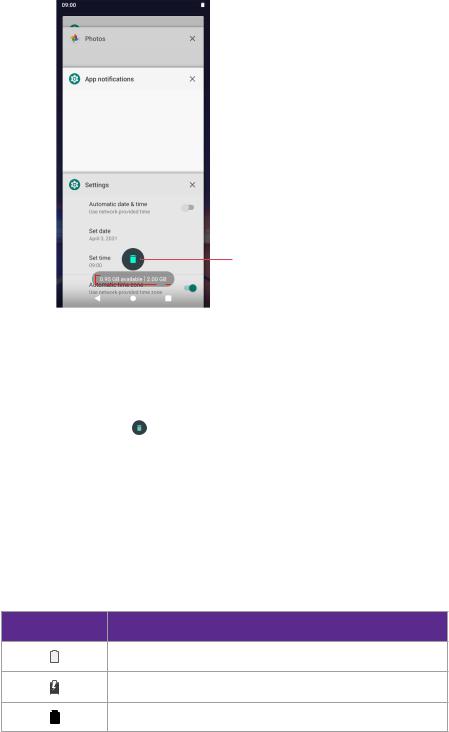
•Tap the Home button to return to the Home screen, and then tap the icon of the app you want to open.
•Tap Recent apps button to view the recently used apps, then tap the app you want to open.
•Double-tap Recent apps button to switch to the previous app.
Viewing recently used apps
Tap Recent apps button to display the list of recently used apps.
 Close the app
Close the app
Close all apps

 The number of background apps and memory usage
The number of background apps and memory usage
•View more apps: Swipe up or down on the screen to view more recently used apps.
•Open an app: Tap a thumbnail to open the corresponding app.
•Close an app: Swipe left or right on a thumbnail to close the corresponding app, or you can tap
 on a thumbnail to close it.
on a thumbnail to close it.
• Close all apps: Tap to close all the background apps.
2. 4 Status bar
Use the status bar to access the Quick Settings Panel, Notification Panel and check your phone’s status.
Status icons
Status icons are displayed on the right-hand side of the status bar and tell you about your phone’s status, including network connections, signal strength, battery, and time.
Status icons |
Indications |
Battery low
Charging
Battery full
Chapter 2 . Basics |
12 |
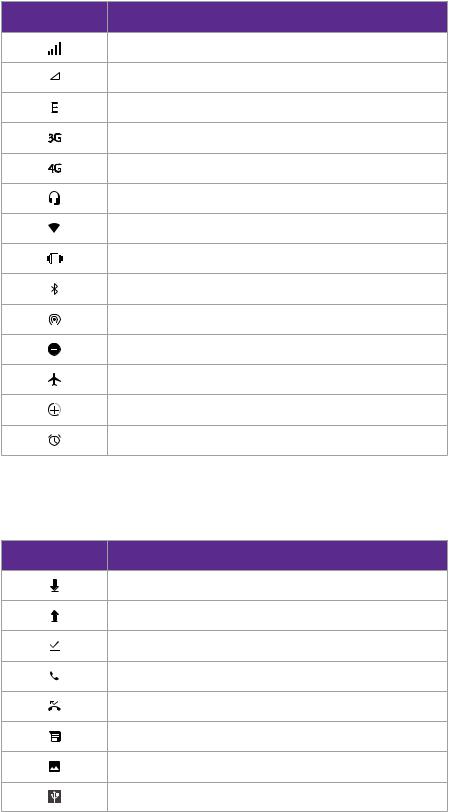
Status icons |
Indications |
Signal strength
No service
Connected over GPRS
Connected over 3G
Connected over 4G
Headset mic inserted
WLAN connected
Vibrate mode enabled
Bluetooth enabled
Hotspot enabled
Do not disturb enabled
Airplane mode enabled
Data saver enabled
Alarms enabled
Notification icons
Notification icons are displayed on the left-hand side of the status bar when you receive a new message and other notifications.
Notifications icons |
Indications |
Downloading status
Uploading data
Download complete
Call in progress
Missed calls
New messages
Screenshots
USB tethering active
Chapter 2 . Basics |
13 |
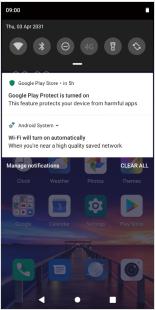
2. 5 Notification Panel
Notification Panel collects all the notifications and alerts so that you can review them whenever you like.
Use Notification Panel
 Notification
Notification
 Tap to remove all the notifications at once
Tap to remove all the notifications at once
•Open Notification Panel: Swipe down from the status bar to open the Notification Panel.
•View a notification: When there is a notification reminder, you can open the Notification Panel and tap the notification item to view the details. From the Lock screen, new notifications, such as missed calls and messages are displayed on it. Double-tap it to view the details.
•Clear notifications: Swipe the notification left or right to remove it from the list. You can also tap CLEAR ALL to remove all the notifications at once. From the Lock screen, swipe left or right to remove the notification.
•Close Notification Panel: Swipe up, or tap the Home button or Back button.
2. 6 Quick Settings Panel
Use shortcut switches on the Quick Settings Panel to enable or disable functions quickly without using a settings menu.
Use Quick Settings Panel
•Open the Quick Settings Panel: Swipe down twice from the status bar to open the Quick Settings Panel. On the Lock screen, swipe only once to open it.
•Use shortcut switches: Tap the shortcut switches on the Quick Settings Panel to turn on or turn off the functions. Tap and hold the shortcut icon to enter the feature’s settings page.
•Close the Quick Settings Panel: Swipe up, or tap the Home button or Back button.
Chapter 2 . Basics |
14 |
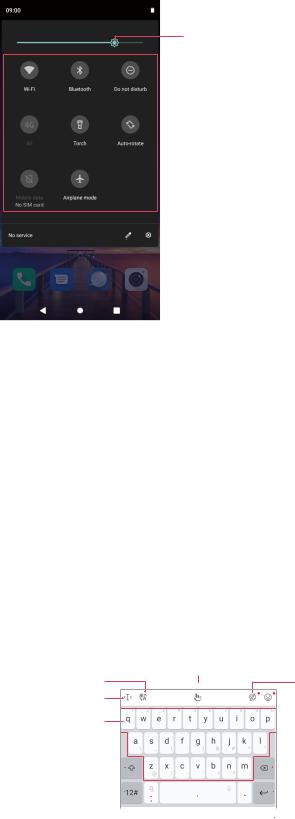
Brightness slider: Use this slider to adjust the
brightness of the screen
 Shortcut switches: Tap to enable/disable functions quickly
Shortcut switches: Tap to enable/disable functions quickly
 Settings: Tap to go to Settings
Settings: Tap to go to Settings
 Edit: Tap to enter the edit page
Edit: Tap to enter the edit page
Adjust the position of shortcut switches
Open the Quick Settings Panel and tap  to enter the edit page. You can:
to enter the edit page. You can:
•Rearrange shortcut switches: Tap and hold a shortcut switch, then drag the icon to a position of your choice.
•Add a shortcut switch: Drag a shortcut switch from the bottom section of the panel to the top section.
•Remove a shortcut switch: Drag a shortcut switch from the top section of the panel to the bottom section.
•Reset Quick Settings Panel: Tap  > Reset to reset the Quick Settings Panel to default settings.
> Reset to reset the Quick Settings Panel to default settings.
2. 7 Type text
Enter text
The keyboard enables you to enter text when needed. Your phone uses Touchpal by default.
Choose language Edit the content
Touch and hold the letter to enter the number or symbol next to it
Tap it and then tap a letter to type uppercase
Double-tap for caps lock
Enter numbers, punctuations and symbols
Enter a comma. Tap and hold it to turn on/off prediction
Set the keyboard
Choose the theme
 Insert emoji
Insert emoji
|
|
|
|
|
|
|
|
|
|
Delete the characters to the |
|
|
|
|
|
|
|
|
|
|
left of the cursor |
|
|
|
|
|
|
|
|
|
|
Start a new line |
|
|
|
|
|
|
|
|
|
||
|
|
|
|
|
|
|
|
|
|
Change keyboard |
|
|
|
|
|
|
|
|
|
|
|
|
|
|
|
|
|
|
|
|
||
|
|
|
|
|
|
|
|
|
|
Enter a period. Tap and |
|
|
|
Enter a |
space |
|
|
|
|||
|
Double-tap to end a sentence with a period |
|
hold to enter a symbol |
|||||||
 Note: The image shows the layout of the American English keyboard. The layout may vary depending on the specific language used.
Note: The image shows the layout of the American English keyboard. The layout may vary depending on the specific language used.
Chapter 2 . Basics |
15 |
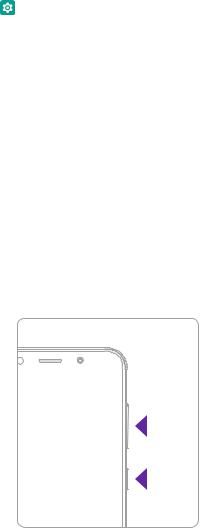
Spell checker
You can turn on the Spell checker feature to help you enter correct words.
1.On the Home screen, tap Settings > System > Languages & input > Advanced > Spell checker.
2.Turn on Use spell checker.
Switch input method
1.On the Home screen, tap  Settings > System > Languages & input > Virtual keyboard.
Settings > System > Languages & input > Virtual keyboard.
2.Select an input method you need.
Manage keyboards
1.On the Home screen, tap  Settings > System > Languages & input > Virtual keyboard.
Settings > System > Languages & input > Virtual keyboard.
2.Tap Manage keyboards and toggle the switch next to the keyboard to enable or disable it.
2. 8 Take a screenshot
Press the Power button and Volume-down button simultaneously for about 1 second to take a screenshot.
|
|
|
|
|
|
|
|
|
|
|
|
|
|
|
|
|
|
|
|
|
|
|
|
|
Chapter 2 . Basics |
16 |
|||

3 |
Network and Share |
Share your phone data with others by various kinds of connections.
•WLAN
•Mobile data
•Connect to computer
•Bluetooth
•Share your mobile data with other devices
3. 1 WLAN
Connect to a WLAN network to access the internet and reduce mobile data usage.
 Note: Your personal data and financial information may be at risk if you connect to insecure public WLAN networks.
Note: Your personal data and financial information may be at risk if you connect to insecure public WLAN networks.
Connect to a WLAN network
Enable WLAN to connect to the internet using a WLAN access point or hotspot.
1.Swipe down from the status bar to open the Quick Settings Panel.
2.Tap and hold  WLAN and select the WLAN network you want to connect to:
WLAN and select the WLAN network you want to connect to:
•If the WLAN network does not require a password, just tap it to automatically connect.
•If the network is protected, enter the password when prompted and tap CONNECT.
•If you can’t find the target WLAN network on the list, tap Add network and enter the network information and save.
3. After connected, will be displayed in the status bar. Your phone will remember WLAN networks that you have joined before and reconnect to them automatically.
Configure WLAN settings:
On the WLAN screen, you can:
•Refresh the list: Swipe down to refresh the available WLAN list.
•Add a WLAN network that is not shown in the list: Swipe up to the bottom of the list and tap Add network. Follow the onscreen instructions to configure the WLAN settings and password.
•View and manage saved networks: Swipe up to the bottom of the list and tap Saved networks to view the saved network list.
Connect to a WLAN network through WPS
Connecting to a WPS-enabled router over WPS allows you to quickly connect to the network without entering a password.
On the Home screen, tap Settings > Network & internet > WLAN. Swipe up to the bottom of available WLAN networks list and tap WLAN preferences > Advanced.
You can connect to your router by following two ways:
•Tap WPS Push Button and press the router’s WPS button.
•Tap WPS Pin Entry to generate a PIN, and then enter the PIN on the router.
Chapter 3 . Network and Share |
17 |

Install certificates
1.On the Home screen, tap Settings > Network & internet > WLAN. Swipe up to the bottom of available WLAN networks list and tap WLAN preferences > Advanced.
2.Tap Install certificates and follow the onscreen instructions to install certificates you need.
Configure WLAN
On the Home screen, tap available WLAN networks
Settings > Network & internet > WLAN. Swipe up to the bottom of list and tap WLAN preferences.
You can configure these settings:
•Manage network notification: Switch on Open network notification, and your phone will notify you when a public network is available.
•View your MAC and IP address: Tap Advanced to view your MAC address and IP address.
3. 2 Mobile data
Enable mobile data to access the internet, when WLAN is not available.
Enable mobile data
You can enable mobile data in following ways:
•Swipe down twice from the status bar to open the Quick Settings Panel and then tap  Mobile data to enable mobile data.
Mobile data to enable mobile data.
•Go to Settings > Network & internet > Mobile network, select a SIM card if you have inserted
two cards, and then turn on Mobile data switch.
 Note:
Note:
1.Before using mobile data, ensure that you have a data plan with your carrier to avoid incurring excessive data charges.
2.If a WLAN connection to the internet isn’t available, apps and services may transfer data over your carrier’s cellular network, which may result in additional fees. Contact your carrier for information about you cellular data plan rates.
3.When you don’t need to access the internet, disable mobile data to save battery power and reduce data usage.
Configure mobile data
On the Home screen, tap  Settings > Network & internet > Mobile network, you can:
Settings > Network & internet > Mobile network, you can:
•Enable mobile data: Switch on Mobile data to enable it.
•Manage data roaming: Switch on Roaming to enable your phone to connect to data services when roaming.
 Note: Connecting data services when roaming may result in additional fees.
Note: Connecting data services when roaming may result in additional fees.
•App data usage: Tap to view mobile data usage off apps.
•Mobile data always online: Turn on the switch to use more battery power on some mobile netwroks.
•Enhance 4G LTE Mode: Turn on the switch to use LTE services to improve voice and other communications.
•Preferred network type: Choose 4G, 3G or 2G network.
•Carrier video calling: Turn on the switch to enable carrier video calling.
•Select the VoLTE video resolution: Tap to select the VoLTE video resolution.
•Automatically select network: Tap to choose APNs.
Chapter 3 . Network and Share |
18 |

3. 3 Connect to computer
Use a USB cable to connect your phone to your computer and transfer data.
Select the USB connection mode
1.Use a USB cable to connect your phone to the computer.
2.Swipe down from the status bar to open the Notification Panel, tap Charging this device via USB to expand the notification. Then you can choose one of the following USB connection modes:
•Charge only: Charge your phone only.
•Media device (MTP): Transfer media files, such as photos, songs, and videos between your phone and the computer.
•Camera (PTP): Transfer images between your phone and the computer.
•MIDI: Use your phone as a MIDI input device and play MIDI files on the computer.
•USB virtual drive: Use your phone as a USB virtual drive and transfer files between your microSD card and computer.
3.4 Bluetooth
Use Bluetooth to share data on your phone with other devices. And you can use Bluetooth to connect your phone to Bluetooth headsets and in-car Bluetooth to navigate or listen to music while you drive. You can also connect your phone to Bluetooth wearables to record and manage fitness data. Connecting Bluetooth devices to your phone does not increase power consumption significantly.
Enable Bluetooth
Swipe down from the status bar to open the Quick Settings Panel and tap  Bluetooth to enable Bluetooth quickly. Once Bluetooth is enabled,
Bluetooth to enable Bluetooth quickly. Once Bluetooth is enabled,  will be displayed in the status bar.
will be displayed in the status bar.
Pair your phone with another device
1.Tap and hold  Bluetooth in the Quick Settings Panel to enter the Bluetooth screen.
Bluetooth in the Quick Settings Panel to enter the Bluetooth screen.
2.Tap Pair new device. Your phone will automatically list available devices. If the device you want to pair is not displayed, swipe down to refresh available devices list, or check whether the device is discoverable.
 Note: To quickly pair the devices you have paired before, tap Previously connected devices and tap the target device.
Note: To quickly pair the devices you have paired before, tap Previously connected devices and tap the target device.
3.From Available devices, tap the device you want to pair and then follow the onscreen instructions to complete pairing.
Send and receive files using Bluetooth
Check that both devices are paired before attempting to transfer files.
•Send files: Tap the file you want to send and tap 
 >
>  Bluetooth, and then select the receiving device.
Bluetooth, and then select the receiving device.
•Receive files: When another device tries to send you files using Bluetooth, select ACCEPTfrom the dialog box that appears.
•View received files: You can view received files in following ways:
•Swipe down from the status bar to open the Notification Panel. Then tap the downloaded notification to view file transfer progress.
•Go to Bluetooth screen and tap Connection preferences > Received files.
Chapter 3 . Network and Share |
19 |

•On the Home screen, go to Tools > Downloads >  > Recent.
> Recent.
Manage paired devices
On the Currently connected list, tap a paired device to configure followings things:
• Rename paired devices: Tap  and then enter the new name in the name field and tap RENAME to save your configuration.
and then enter the new name in the name field and tap RENAME to save your configuration.
•Manage permissions: Toggle Internet access and Contact sharing switches to set your internet and contact permissions.
•Unpair Bluetooth devices: Tap FORGET.
Rename your device
1.Tap and hold  Bluetooth in the Quick Settings Panel to enter the Bluetooth screen and tap
Bluetooth in the Quick Settings Panel to enter the Bluetooth screen and tap
Connection preferences > Bluetooth > Device name.
2.Edit the device name and tap RENAME to complete the configuration.
3.5 Share your mobile data with other devices
You can use WLAN hotspot, USB cable, or Bluetooth to share your mobile data with other devices (such as phones, tablets, or computers).
Use WLAN hotspot
Set up a portable WLAN hotspot to share your phone’s mobile internet with other devices. Compared with Bluetooth tethering, the portable WLAN hotspot feature offers quicker, longer range connections, but power consumption is higher.
 Note: Your device can’t access the internet using WLAN when your Portable WLAN hotspot is turned on.
Note: Your device can’t access the internet using WLAN when your Portable WLAN hotspot is turned on.
•Open WLAN hotsopt
1. On the Home screen, tap Settings > Network & internet > Hotspot & tethering > WLAN hotspot.
2. Turn on the switch. After enabling your personal WLAN hotspot, will be displayed in the status bar.
•Configure WLAN hotspot
On the WLAN hotspot screen, you can configure following settings. After finishing, tap SAVE.
•Change the hotspot name: Enter your hotspot name that is easier to remember and tap OK. By default, the network name is your phone model.
•Change the security setting: Your phone uses WPA2 PSK encryption by default. Other devices will require a password to connect to the hotspot. If you choose None, other devices will not require a password to connect to your hotspot.
•Configure the password: Tap Hotspot password and enter the new password.
•Turn off hotspot automatically: Turn on the switch and if no devices are connected, the WLAN hotspot will be turned off.
•Select a AP band: Your device only supports 2.4 GHz Band.
•Configure the maximum number of connections: Change the maximum number of connections. Your phone will allow up to 10 users to connect to the hotspot.
•WPS connect: Select WPS mode.
•Hotspot control mode: Select hotspot control mode.
•Manage users
On WLAN hotspot screen, you can view and manage the connected and blocked users. You can tap Manually Add WhiteList Device to add users in white list.
Chapter 3 . Network and Share |
20 |

Use USB tethering
Use a USB cable to share your phone’s mobile internet with a computer. This is useful if your computer’s internet connection stops working. To enable mobile data, see Enable mobile data.
To enable USB tethering:
1.Connect your phone to a computer using a USB cable.
2.On the Home screen, tap  Settings > Network & internet > Hotspot & tethering.
Settings > Network & internet > Hotspot & tethering.
3.Switch on USB tethering. After enabling USB tethering, 
 will be displayed in the status bar.
will be displayed in the status bar.
Then you can use the computer to access the internet.
 Note: Depending on your computer’s operating system, you may need to install phone drivers on the computer or establish a network connection in order to use USB tethering. Please read the instructions for your operating system.
Note: Depending on your computer’s operating system, you may need to install phone drivers on the computer or establish a network connection in order to use USB tethering. Please read the instructions for your operating system.
Use Bluetooth tethering
Use Bluetooth tethering to turn your phone into a wireless router and share your mobile internet with other devices. Compared with a portable hotspot, Bluetooth tethering offers a slower internet connection, but consumes less power.
1.Establish a Bluetooth connection between two devices and check that they are paired. For more information about Bluetooth connection, see Pair your phone with another device.
2.On the Home screen, tap Settings > Network & internet > Hotspot & tethering, and switch on Bluetooth tethering.
3.On your device, swipe down from the status bar to open the Quick Settings Panel, then tap and hold  to go to the Bluetooth screen. On the Currently connected list, tap the paired device and switch on Internet access to share your mobile data with the paired device.
to go to the Bluetooth screen. On the Currently connected list, tap the paired device and switch on Internet access to share your mobile data with the paired device.
Chapter 3 . Network and Share |
21 |
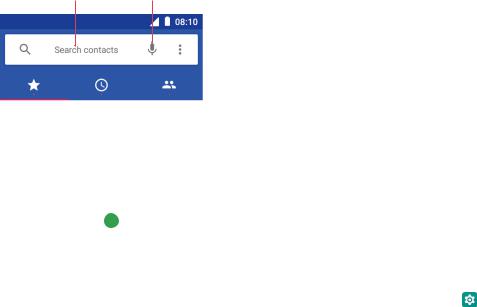
4 |
Calls and Contacts |
Make calls with your phone to contact one quickly.
•Make a call
•Answer or reject a call
•Options during a call
•Call log
•Call history
•Call settings
•Contacts
4. 1 Make a call
Search barGoogle voice typing
 More, include Call history,
More, include Call history,
Clear frequents and Settings
Favorite |
|
contactsCall |
|
log |
|
|
|
|
Contact list |
||||
Make a call form dialer screen
1.On the Home screen, tap  Phone >
Phone >  .
.
2.Enter a phone number and tap  to make a call. When entering part of the phone number or the first letter of the contact’s name, your Phone will automatically search for the relevant contacts and call log. Tap the contact you want to call in the list. If you have inserted two SIM cards and
to make a call. When entering part of the phone number or the first letter of the contact’s name, your Phone will automatically search for the relevant contacts and call log. Tap the contact you want to call in the list. If you have inserted two SIM cards and
didn’t set the default SIM for calls, select SIM1 or SIM2 to dial.
 Note: Check Remember this choice and tap SIM1/SIM2 to make SIM1 or SIM2 as the default SIM card to make calls. If you want to change the default SIM card, or if you want to deactivate one of them, go to Settings > Network & internet > SIM cards to configure. For more information about dual SIM settings, see Dual SIM settings.
Note: Check Remember this choice and tap SIM1/SIM2 to make SIM1 or SIM2 as the default SIM card to make calls. If you want to change the default SIM card, or if you want to deactivate one of them, go to Settings > Network & internet > SIM cards to configure. For more information about dual SIM settings, see Dual SIM settings.
Dial a recent number from the Call log
All incoming, outgoing and missed calls are in the call log.
1.On the Home screen, tap  Phone >
Phone >  , a list of recent calls will be displayed.
, a list of recent calls will be displayed.
2.Select a number or contact and tap  to make a call.
to make a call.
Dial from Contact list
1.On the Home screen, tap  Phone >
Phone >  .
.
2.Tap the contact you want to call in the list and then tap the number to dial.
Dial from your favorites
1. On the Home screen, tap  Phone >
Phone >  .
.
Chapter 4 . Calls and Contacts |
22 |

2. Tap the contact directly to call.
Dial from contact list and call log search results
1.On the Home screen, tap  Phone.
Phone.
2.Tap the search bar and enter the name, initials, or number of a contact.
3.Tap the contact to dial. If no contacts appear, you can enter the full phone number and tap Call to dial directly, or tap  Send a message to send a message to the number.
Send a message to send a message to the number.
Make an international call
1.On the Home screen, tap  Phone >
Phone >  .
.
2.Tap and hold 0 key to enter a + symbol, and then enter the country code, area code, and phone number.
3.Tap  to call.
to call.
Make an emergency call without SIM cards
In the event of an emergency, you can make emergency calls from your device, even without a SIM card.
•Make an emergency from unlock screen
1. On the Home screen, tap  Phone >
Phone >  .
.
2. Enter the emergency number for your location in the dialer and tap  .
.
•Make an emergency from Lock screen
If you enabled the device protection (pattern, PIN or password), you can make an emergency from Lock screen in the following way:
1. Wake up the screen and swipe up on the screen.
2. Tap EMERGENCY.
3. Enter the emergency number of your location in the dialer and tap  .
.
 Note:
Note:
1.You must be in an area with cellular coverage, when you have to make an emergency call.
2.The ability to make emergency calls depends on local regulations and carriers in your area.
3.Poor network coverage or environmental interference may prevent your call from being connected. Never rely solely on your device for essential communication during emergencies.
4.2 Answer or reject a call
Answer or reject a call
 Note: When a call comes in, you can press the Volume button or Power button to mute the ringtone.
Note: When a call comes in, you can press the Volume button or Power button to mute the ringtone.
•When the screen is unlocked:
Tap ANSWER to answer the call. Tap DECLINE to reject the call.
Ne os
|
|
|
Chapter 4 . Calls and Contacts |
23 |
|

•When the screen is locked:
•Answer a call: Swipe  up or just swipe up on the screen to answer the call.
up or just swipe up on the screen to answer the call.
•Reject a call: Swipe  down or just swipe down on the screen to reject the call.
down or just swipe down on the screen to reject the call.
•Quick response message: Swipe  up to reject the call and select a quick response message to the caller. Or you also can tap Write your own and enter your own response message, then tap SEND.
up to reject the call and select a quick response message to the caller. Or you also can tap Write your own and enter your own response message, then tap SEND.
Ne os
4. 3 Options during a call
In-call menu
During a call, your phone will display an in-call menu.
|
|
|
|
|
|
|
|
Show/hide dialer |
|
|
|
|
|
|
|
|
|
Mute the call |
|
|
|
|
|
|
|
Enable hands-free mode |
|
|
|
|
|
||||
Start a three-way call |
|
|
|
|
|
|
|
Place the current call on hold |
|
|
|
|
|
|
End the call
Chapter 4 . Calls and Contacts |
24 |
